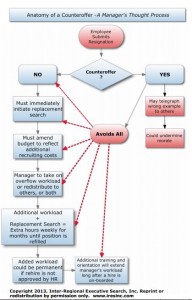Ben Franklin said “An ounce of prevention is worth a pound of cure.” It’s an old English proverb (as in Ye Olde) that goes back many centuries even prior to Franklin.
Counteroffers are now rampant. One out of every three offers involving recruiters (i.e. candidates that were not looking for a job in the first place) are resulting in counteroffers in my office and with our clients.
The only way to prevent a counteroffer from derailing three months or more of search work is to have the right offer presented in the first place. This means the strongest possible offer in terms of salary denomination, and perks, benefits, hiring/starting bonus etc. No low-balling, no slightly-less-offers, no let’s-test-the-waters offers, etc.
All the ammunition available should be presented to the candidate prospect without having to force the candidate to engage in petty negotiations. A good offer is the best prevention. It’s worth pounds and pounds of cure. But everyone has a different idea of what a good offer is.
Most offers are presented at percentages that are 10-20% above the recruited individual’s current salary. Many factors weigh in on what percentage increase will be necessary including:
- Local cost of living.
- Average industry wage for the compensation level being filled.
- Internal HR compensation tiers.
- Scarcity of talent in that particular niche.
Offer Formula
Generally speaking, offer percent increases fall into these general ranges:
- 0-10% = Poor to Fair Offer Increase
- 10-20% = Fair to Very Good
- 20% – 30% = Good to Excellent
- Above 30% = Outstanding
Most counteroffers are lame; the equivalent of tossing a bone out to someone whom the original company suspects does not really have the chutzpah to resign in the first place. Since the company suspects the resigning individual is undecided, easily dissuaded, or lacking in follow-through, that individual is likely to be presented with a counteroffer. To the company the candidate is being recruited from, a counteroffer is their ounce of prevention that is far cheaper than finding and training a new hire, which could take months or years.
Generally speaking counteroffers are usually anemic. Rarely do counteroffers exceed 10-12.5% of the individual’s current salary. They also rarely work in favor of the formerly-resigning-but-now-changing-his-mind candidate. *See why by viewing the flow chart.
Here are a few other considerations regarding counteroffers:
- They usually come at the expense of next year’s or years’ raise.
- They can create some resentment internally.
- They often come with other strings or promises rarely carried through by management as once the offer has been rejected, and the risk of departure forestalled, the company is no longer in a bind.
Deflecting Counteroffers
One thing is for certain, the days of a standard 10% increase-in-salary offer are gone. 15% salary increases have become, in many specialties, the de facto baseline in what is now a fiercely competitive job market in many niches.
If you think you’ll get someone now earning $150k to move for $165K (10% more) your offer stands a much higher probability of being rejected or crumbling apart under the pressure of a counter-offer, even if all other items line up correctly.
 See the chart on offer percentage differentials to determine if your offer is sufficiently above the level of someone’s current base salary to withstand the threat of a counteroffer.
See the chart on offer percentage differentials to determine if your offer is sufficiently above the level of someone’s current base salary to withstand the threat of a counteroffer.
It surprises some clients and executives when we tell them offers are increasingly being presented at salaries are 20-35%, and even 40-50% above someone’s current salary — an upward trend that has accelerated since 2012.
Keep in mind these percentages involve college educated professionals, often comfortable in their current job, with rare talent that is usually scarce, and involves being recruited away (was not actively looking in the first place).
This is yet another reason why a seasoned, experienced, search firm with a 20 year track record of experience, can be highly worth a company’s investment.
The best way of avoiding and “bullet-proofing” your offer to resist a counteroffer, is to have the percentage increase — the percentage the new offer represents above someone’s current salary — within the “counter-offer resistance range” necessary to deflect a counteroffer.
If counteroffers in a particular niche are commonly no greater than 12%, then an offer that is 20% above the individual’s current salary will be necessary as the baseline.
Other Considerations
Other considerations will also have to line up of course. These include:
- Annual bonus
- Auto allowance
- Career promotional opportunity
- New position fulfilling the candidate’s motivating objectives
Nothing will matter in the end if the percentage increase of the new offer does not sufficiently exceed the benefits of accepting a counteroffer. The percentage must be 15-20% greater in the currently fierce conditions we’re encountering or all other bets are off.
